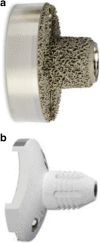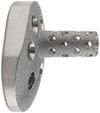Baseplate Options for Reverse Total Shoulder Arthroplasty
- PMID: 33034820
- PMCID: PMC7661608
- DOI: 10.1007/s12178-020-09677-1
Baseplate Options for Reverse Total Shoulder Arthroplasty
Abstract
Purpose of review: Baseplate fixation has been known to be the weak link in reverse total shoulder arthroplasty (RTSA). A wide variety of different baseplates options are currently available. This review investigates the recent literature to present the reader with an overview of the currently available baseplate options and modes of fixation.
Recent findings: The main elements that differentiate baseplates are the central fixation element, the size of the baseplate, the shape, the backside geometry, whether or not an offset central fixation exists, the number of peripheral screws, and the availability of peripheral augmentation. The wide array of baseplate options indicates that no particular design has proven superiority. As such, surgeons should be aware of their options and choose an implant that the surgeon is comfortable with and one that best suits the individual patient anatomy. With the growing number of RTSA procedures and registries with long-term follow-up, future investigations will hopefully delineate the ideal baseplate design to optimize survivorship.
Keywords: Baseplate; Glenoid implant; Metaglene; Shoulder arthroplasty; Shoulder implant; Shoulder replacement.
Conflict of interest statement
Wassim Mourad, Alexander Martusiewicz, and Brett P. Wiater declare that they have no conflict of interest.
J. Michael Wiater reports personal fees from Zimmer Biomet, personal fees from Depuy Synthes, outside the submitted work.
Figures








Similar articles
-
Impact of screw length and screw quantity on reverse total shoulder arthroplasty glenoid fixation for 2 different sizes of glenoid baseplates.JSES Open Access. 2019 Nov 1;3(4):296-303. doi: 10.1016/j.jses.2019.08.006. eCollection 2019 Dec. JSES Open Access. 2019. PMID: 31891029 Free PMC article.
-
Bone Grafting the Glenoid Versus Use of Augmented Glenoid Baseplates with Reverse Shoulder Arthroplasty.Bull Hosp Jt Dis (2013). 2015 Dec;73 Suppl 1:S129-35. Bull Hosp Jt Dis (2013). 2015. PMID: 26631209
-
Reverse shoulder glenoid baseplate fixation: a comparison of flat-back versus curved-back designs and oval versus circular designs with 2 different offset glenospheres.J Shoulder Elbow Surg. 2014 Sep;23(9):1388-94. doi: 10.1016/j.jse.2014.01.050. Epub 2014 Apr 13. J Shoulder Elbow Surg. 2014. PMID: 24739792
-
Ten technical aspects of baseplate fixation in reverse total shoulder arthroplasty for patients without glenoid bone loss: a systematic review.Clin Shoulder Elb. 2024 Mar;27(1):88-107. doi: 10.5397/cise.2023.00493. Epub 2023 Dec 19. Clin Shoulder Elb. 2024. PMID: 38147872 Free PMC article. Review.
-
[Glenoid reconstruction in revision shoulder arthroplasty].Oper Orthop Traumatol. 2019 Apr;31(2):98-114. doi: 10.1007/s00064-019-0594-8. Epub 2019 Mar 15. Oper Orthop Traumatol. 2019. PMID: 30874867 Review. German.
Cited by
-
Recent Advances in the Design and Application of Shoulder Arthroplasty Implant Systems and Their Impact on Clinical Outcomes: A Comprehensive Review.Orthop Res Rev. 2024 Jul 26;16:205-220. doi: 10.2147/ORR.S312870. eCollection 2024. Orthop Res Rev. 2024. PMID: 39081796 Free PMC article. Review.
-
Average Indian Glenoid Sizes Are Smaller than All Commercially Available Glenoid Components: A Systematic Review.Indian J Orthop. 2023 Apr 21;57(7):1008-1022. doi: 10.1007/s43465-023-00885-8. eCollection 2023 Jul. Indian J Orthop. 2023. PMID: 37384007 Free PMC article. Review.
-
Shoulder arthroplasty in patients with glenohumeral osteoarthritis, glenoid bone loss and an intact rotator cuff: an algorithmic approach and review of the literature.Ann Jt. 2023 Apr 11;8:18. doi: 10.21037/aoj-22-53. eCollection 2023. Ann Jt. 2023. PMID: 38529247 Free PMC article. Review.
-
Implant selection for successful reverse total shoulder arthroplasty.Clin Shoulder Elb. 2023 Mar;26(1):93-106. doi: 10.5397/cise.2022.01193. Epub 2022 Dec 16. Clin Shoulder Elb. 2023. PMID: 36919511 Free PMC article.
-
A narrative review of treatment strategies for major glenoid defects during primary reverse shoulder arthroplasty, with a focus on the use of structural bone graft.EFORT Open Rev. 2023 Oct 3;8(10):759-770. doi: 10.1530/EOR-22-0062. EFORT Open Rev. 2023. PMID: 37787496 Free PMC article. Review.
References
-
- •• Gumina S, Grassi F, Paladini P. Reverse shoulder arthroplasty - current techniques and complications. 1 ed: Springer International Publishing; 2019. XV, 375 p. Comprehensive book discussing the recent advances in RTSA.
Publication types
LinkOut - more resources
Full Text Sources
Research Materials

